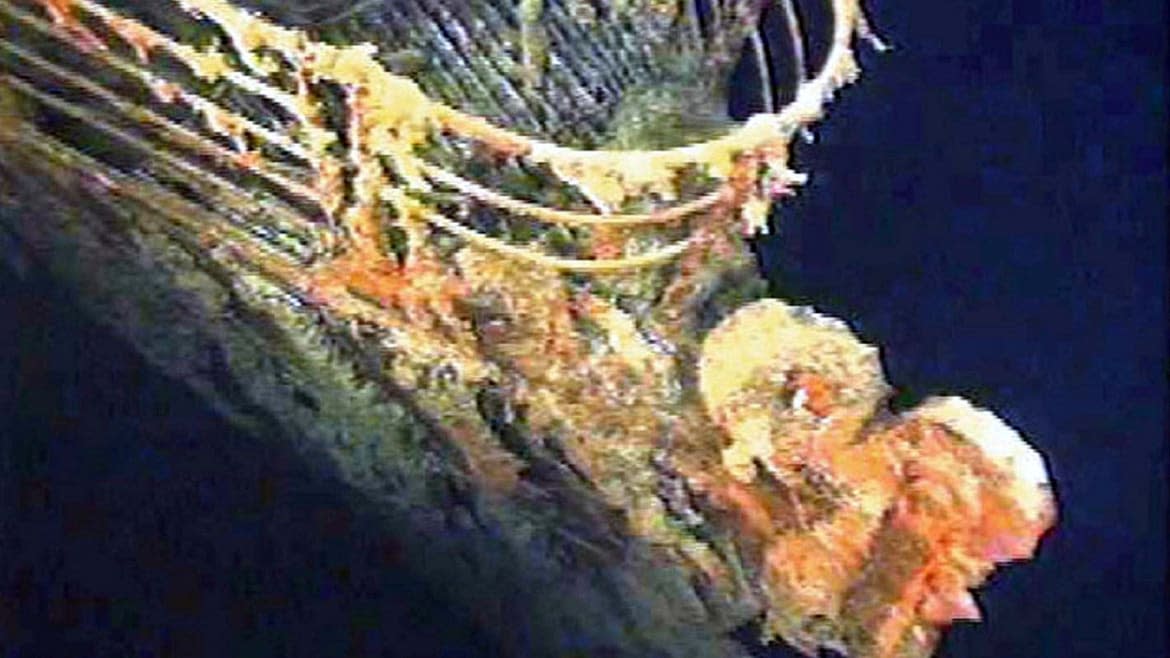Doomed Titanic Submersible Suffered a ‘Catastrophic Implosion’

Officials say debris found on Thursday morning near the wreckage of the Titanic belongs to the submersible that disappeared on a $250,000-a-head trip to the site on Sunday, confirming a tragic end for the five men aboard.
In a press conference, U.S. Coast Guard Adm. John Mauger said the tail cone of the Titan was found 1,600 feet from the bow of the RMS Titanic, consistent with a “catastrophic loss of the pressure chamber” or a “catastrophic implosion” that would have killed all aboard instantly.
Paul Hankins, a salvage expert for the U.S. Navy, said the cone was one of “five major pieces of debris” discovered, which also included the front and back end of the pressure hull.
Mauger said he did not know if there would be an attempt to recover bodies. “This is an incredibly unforgiving environment down there on the seafloor,” he said.
OceanGate Expeditions, owner of the doomed submersible, also conceded that all five passengers are dead. “We now believe that our CEO Stockton Rush, Shahzada Dawood and his son Suleman Dawood, Hamish Harding, and Paul-Henri Nargeolet, have sadly been lost,” the company said.

Pakistani father-and-son Shahzada and Suleman Dawood, OceanGate CEO Stockton Rush, British billionaire Hamish Harding, and French explorer Paul-Henri Nargeolet were aboard the doomed submersible.
The “debris field” was discovered Thursday some 400 miles off the coast of Newfoundland and 12,500 feet underwater by a remotely operated vehicle (ROV) launched from the Horizon Arctic, a Canadian vessel. A French-owned ROV called the Victor 6000, one of few vehicles able to reach the depths of the Titanic, was also deployed around the same time early Thursday morning.
Search crews had narrowed some efforts after hearing underwater “banging noises” on Tuesday night and Wednesday morning but Mauger said Thursday that the noises didn’t come from near where the Titan was eventually found. “There doesn’t appear to be any connection between the noises and the location on the seafloor,” he said.
Marine salvage expert Robert Mester, who declined a trip aboard the Titan’s predecessor, the Antipodes, after seeing the “off-the-shelf hardware” being used to operate the vessel, told The Daily Beast the Titan likely suffered a “catastrophic failure of the hull” on Sunday, somewhere between 4,000 and 5,000 feet down.
“The pressure at that depth is a ton-and-a-half per square inch,” Mester said. “It wouldn’t take much of a failure to cause an implosion, and it would have been instantaneous.”
Expert Who Begged Off a Titanic Sub Mission Saw an Implosion Coming
Mester’s theory is consistent with what officials indicated may have happened. Mauger said sonar buoys placed in the North Atlantic on Monday never detected the sound of an implosion, suggesting the Titan likely suffered the implosion before search and rescue operations commenced.
“On behalf of the United States Coast Guard and the entire unified command, I offer my deepest condolences to the families,” he said.
The Titan submersible lost contact with its mothership on Sunday morning, about an hour and 45 minutes into its roughly two-hour descent to the Titanic site.
There was enough oxygen on board to last 96 hours, according to OceanGate. That meant, under the best possible circumstances, the two crew and three passengers would have run out of air by 7:08 a.m. ET on Thursday.
However, deep-water rescue expert Butch Hendrick previously told The Daily Beast that breathing rates increase as anxiety levels rise, which would more rapidly deplete the Titan’s oxygen supply.
Chilling Tales of Past Dives to Titanic Wreckage Keep Piling Up
Freezing temperatures have also been just as serious an issue. Captain Paul-Henri Nargeolet, who was aboard the missing sub, previously said the cold was “the real problem” in the event the Titan ever became stranded at the seabed.
“After a while, you die because of the cold, which is not a bad way to die because you fall asleep and you don’t suffer, in this case,” he said.
Nicolai Roterman, a deep-sea ecologist and lecturer in marine biology at the University of Portsmouth in the U.K., also speculated that there may have been some kind of hull breach. If so, “The occupants would succumb to the ocean in a near instant, given the more than 5,500 pounds per square inch [PSI] pressure exerted by the ocean at the depth of 3,800m, which is 380 times the air pressure at the surface,” he said.
Roterman added that fire was another “equally unpleasant possibility,” given the oxygen-rich environment inside the submersible.
Red Flags: Titanic Sub Company Was Warned About Safety
The group’s chances of survival, as of Tuesday, were “about one percent,” according to one retired U.S. Navy submarine captain. Still, Coast Guard officials said Wednesday they were holding out hope the group would be found alive.
As an experimental vessel, the Titan never met international safety standards, Hendrick told The Daily Beast. Among other things, it did not have a locator beacon that would have helped rescuers find it. The Titan did have several individual systems giving the ability to surface on its own, but Hendrick noted that none of them would have worked if salt water shorted out the vessel’s electrical system.
Numerous people who have previously been aboard the Titan said they encountered dangerous mishaps while underwater, with one describing the voyage as a “suicide mission.”
“Our hearts are with these five souls and every member of their families during this tragic time,” OceanGate wrote in its statement. “We grieve the loss of life and joy they brought to everyone they knew.”
Get the Daily Beast's biggest scoops and scandals delivered right to your inbox. Sign up now.
Stay informed and gain unlimited access to the Daily Beast's unmatched reporting. Subscribe now.

